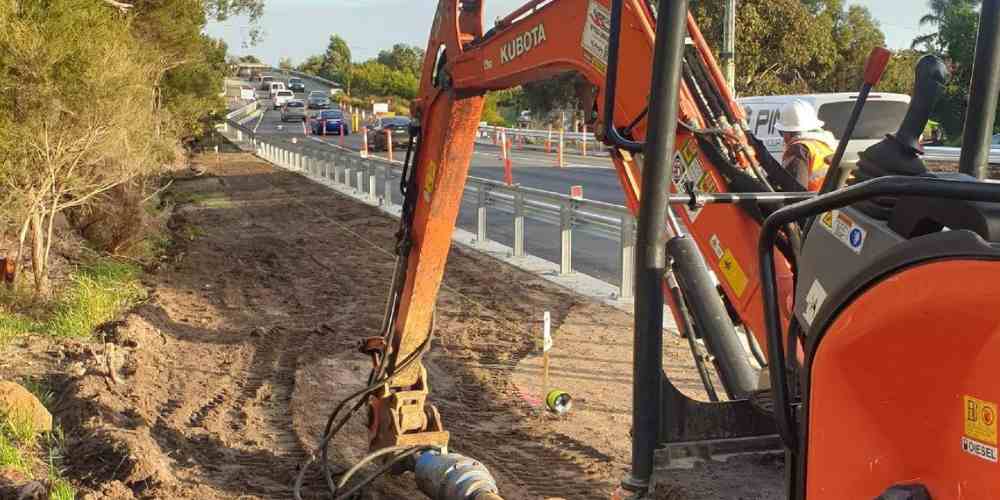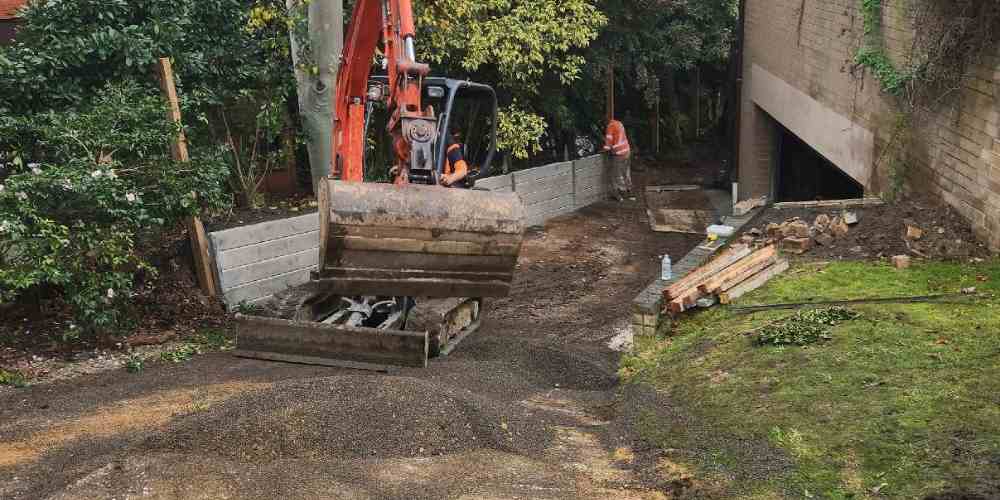Most Commonly Used Equipment in Earthworks: A Comprehensive Guide
Heavy-duty equipment will likely be on site for any size construction project. It is the lifeblood of any building project. This framework turns undeveloped areas into the bases of our hopes for cities. Without these engineering wonders, nothing would be possible, not even the sky-piercing skyscrapers or the complicated web of highways and tunnels that crisscross cities.
If you need an earthwork project on your home, what equipment do you need to prepare?
Find out in this blog as we will be sharing with you what equipment we use in our every earthwork project.

Essential Earthworks Equipment
Earthworks must be performed to make the earth’s surface appropriate for building, landscaping, or other uses. Various specialized equipment is used to accomplish these conversions quickly and effectively. Here, we look at the most crucial earthworks machinery vital to constructing the environment and the scenery around us.
Excavators
With their adaptability and strength, excavators are the workhorses of earthworks. These tools are available in various sizes, from small hydraulic excavators to more portable micro excavators. Excavators are excellent in digging, trenching, and material handling because they combine a boom, stick, and bucket. Their hydraulic systems offer precise control for both delicate procedures and difficult jobs. Excavators are crucial to every earthworks project, from digging utility trenches to foundations.
Bulldozers
The terms “bulldozers” and “earthmoving” are often used interchangeably. These sturdy machines include a front blade that is rather big and can push or grade dirt, pebbles, and trash. Bulldozers have good traction and weight distribution because of their tracks, and they can level uneven ground and make slick slopes. Bulldozers are useful for moving material; they may also clear land and prepare a location.
Loaders
For transporting and loading items, loaders are a must. They come in a front-end loader and backhoe variations. To load loose materials into trucks, such as dirt, gravel, and other materials, front-end loaders employ a large bucket mounted to the front of the machine. On the other hand, backhoes come equipped with a loader bucket and may dig and excavate. Loaders are crucial in loading vehicles to move items around a job site.
Dump Truck
Transporting bulk materials short to medium distances, such as dirt, gravel, sand, and waste, requires dump trucks. The hydraulic bed of typical dump trucks may be tilted to unload the payload. A pivoting joint between the cab and the bed of articulated dump trucks, frequently utilized in rugged terrain, improves mobility. These trucks provide effective material mobility on the job site, improving workflow.
Specialized Equipment for Earthworks
While basic earthmoving tools like bulldozers and excavators may tackle various jobs, some specialist tools increase productivity and accuracy for particular construction and earthmoving demands. This section looks at the cutting-edge equipment used for specific types of earthworks.
Compactors
Compactors are essential to achieve correct soil compaction and ensure a solid foundation for construction. Plate compactors, smooth-drum rollers, and pneumatic compactors are just a few available varieties. These devices reduce settlement and increase load-bearing capacity by applying pressure to the soil by filling air gaps. Compaction is necessary for roads, building foundations, and other structures to have a solid foundation.
Graders
One of the most important parts of landscaping a sloping garden is controlling water drainage. Put up a reliable drainage system to stop water from damaging and eroding the slope. Swales, French drains, or catch basins are a few elements to consider when designing measures to divert water away from sensitive locations. Your slope’s integrity will be preserved, and the erosion risk will be reduced with proper water management.
Pavers
Paving equipment is necessary to construct roads, walkways, and other paved surfaces. While concrete pavers work with cement-based products, asphalt pavers lay down hot mix asphalt. These tools provide even material distribution and appropriate compaction, producing tough and even surfaces. Pavers play a crucial role in building transportation- and community-connecting infrastructure.
Selecting the Right Equipment for Earthworks Projects
Project Scope and Size
The kind and size of equipment you’ll require depends on the size of your earthworks project, whether it’s a little home project or a large commercial development. Ensuring that the equipment’s capabilities match the work at hand, the project’s scope may be matched to maximize efficiency and production.
Task Specificity
Specialized equipment is required for various earthworks jobs, including excavation, grading, and material transport. Making ensuring you have the right instruments for accurate and efficient execution requires matching your equipment selection to the particular activities required.
Site Conditions
Equipment selection is greatly influenced by the type of soil present at the site and its characteristics. To achieve optimal results, your tools must be appropriate for the site’s characteristics, whether working with rocky terrain, clayey soil, or soft sand.
Topography and Terrain
The location’s topography, including slopes and elevation variations, immediately influences how well the machinery works. Equipment that is mobile and stable enough for the terrain guarantees safe and effective operation in a variety of landscapes.
Type of Material and Volume
Equipment selection is influenced by your knowledge of the materials you’ll be dealing with, such as loose dirt, large boulders, or garbage. The handling volume and the qualities of the materials should be compatible with the equipment’s capacity and capabilities.
Accessibility and Space Constraints
The kind of equipment you can employ depends on the accessibility of your project location and any space restrictions. Compact and agile equipment becomes necessary to sustain operating efficacy in confined locations or regions with limited entrance points.
Project Schedule
The timeframe for your project dictates the pace of equipment selection. By selecting equipment compatible with the project’s schedule, jobs may be finished within the allocated time, preventing delays and maintaining the project’s course.

Renting vs. Buying Equipment
For earthwork projects, deciding between renting and buying equipment requires assessing several considerations. Renting enables freedom to obtain specialist equipment without long-term commitments and cost-effectiveness as no upfront purchase is required. Access to modern technologies and maintenance assistance is also included.
However, leasing prices might increase, and availability can be problematic. On the other side, buying equipment offers a long-term commitment, flexibility in customization, and schedule control. Ownership entails up-front fees, maintenance obligations, and the possibility of depreciation. Decision-making should consider project length, budget, customization requirements, and long-term goals.
Maintenance and Safety Practices for Earthworks Equipment
Maintaining earthworks equipment optimally and ensuring a safe work environment is paramount for successful project execution. Rigorous maintenance and adherence to safety protocols contribute to equipment longevity, operator well-being, and project efficiency. This section delves into the essential maintenance and safety practices that should be observed when working with earthworks equipment.
Equipment Maintenance:
Regular Inspections:
- Perform checks before use to spot any wear, damage, or possible problems.
- Examine the fluid levels, hoses, belts, and attachments often to ensure everything operates properly.
Scheduled Maintenance:
- Follow the suggested maintenance schedules from the manufacturer for regular servicing, such as oil changes, filter replacements, and lubrication.
- Keep thorough maintenance logs to monitor the equipment’s operation and handle any recurrent problems.
Cleaning and Storage:
- Keep equipment from dirt, debris, and corrosive substances to avoid damage.
- To prevent weather-related wear and tear, store equipment in a covered area.
Proper Lubrication:
- Apply lubricants following the manufacturer’s instructions to decrease wear, stop friction, and prolong component life.
Safety Practices:
Operator Training:
- Ensure operators receive enough instruction on operating the equipment, including safety measures, emergency protocols, and control operation.
- Promote continual training to keep operators informed of equipment improvements and safety rules.
Personal Protective Equipment (PPE):
- Require the use of proper personal protective equipment (PPE) such as helmets, gloves, safety glasses, and high-visibility clothes.
- PPE reduces the danger of harm from debris, falling items, and inclement weather.
Lockout/Tagout Procedures:
- Before doing maintenance or repairs, establish lockout/tagout protocols to disconnect energy sources.
- Ensure the safety of maintenance staff by preventing inadvertent equipment from starting during repair.
Site Planning and Signage:
- Plan the layout of the job site to avoid machinery collisions and pedestrian interactions.
- To designate restricted areas and dangerous zones, use clear signage and obstacles.
Communication and Signals:
To reduce accidents, use standardized hand signals and communication protocols among equipment operators and ground employees.
Emergency Response Plans:
- Create and disseminate emergency response plans for various circumstances, such as equipment failure, accidents, and medical crises.
- Ascertain that all workers know the location of first-aid kits, fire extinguishers, and emergency contacts.
Frequently Asked Questions
Earthworks equipment is designed to perform various activities associated with modifying the earth’s surface, such as excavation, grading, leveling, compacting, and material handling. It is essential in the preparation of construction sites, the construction of foundations, the creation of infrastructure, and the sculpting of landscapes.
Excavators and loaders, for example, may accomplish several duties with the help of various attachments. However, specialized activities, such as compacting and grading, frequently necessitate specially constructed equipment.
Older equipment can still be useful if well-maintained. Still, newer ones frequently have greater efficiency, technological integration, and safety measures. The selection is based on your project’s unique needs and available resources.
Navigating difficult terrains, adapting to various soil types, managing equipment maintenance, dealing with unexpected breakdowns, and assuring operator safety in dynamic work situations are all common issues.
Conclusion
When selecting the best equipment, it’s similar to selecting the correct tools for the job. You assess the scope of the project, the precise tasks required, and the site’s characteristics. Renting or purchasing equipment becomes an adventure in decision-making, balancing short-term convenience with long-term investment.
Maintaining your equipment’s gears is just as important as learning the driving technique—regular inspections and planned maintenance guarantee that your equipment is reliable and ready for use. Speaking about action, safety is like a compass that guides you on your route. Proper training, safety equipment, and regulations keep everyone safe.
